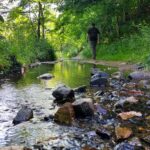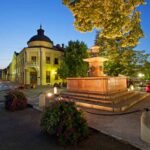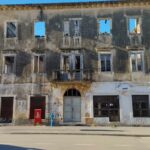Planning a trip to Lake Balaton in Hungary? Here is your complete guide, including things to do, places to see, and castles that are worth visiting.
I had a wish to visit the Hungarian sea, Balaton Lake, for a long time. I’ve been to its counterpart, Palic Lake near Subotica in Serbia, dozens of times.
The architecture at Palic is magnificent, and considering that both of these lakes were part of the same empire, and Balaton is much larger, I was expecting everything to be bigger at Balaton – and I was right.
In this ultimate guide to visiting Balaton Lake in Hungary, I’ll share my experiences and tips to help you make the most of your visit.

How to Get to Lake Balaton?
To get to Lake Balaton, you have three options: train, bus, or car.
Train
There are 4 direct trains daily at 8:07, 12:07, 16:07, and 18:07. The others require a transfer at Székesfehérvár. In Budapest, you can reach the “Kelenföld” railway station by taking the green metro line (M4) to its last stop.
All trains from Budapest to Balatonfüred pass through this station. Some trains depart from the “Déli” station, and others from “Kőbánya-Kispest”, so it’s best to wait at the “Kelenföld” station.
Bus
Lines 1190, 1201, 1202, and 1203 are available.
You can see the bus schedule, as well as other information, on the website of the main bus station “Népliget”, which is located on the M3 metro line.
Siofok

Siófok is the main and largest tourist destination on the southern side of Lake Balaton.
I have been there several times so far. It’s a great place for those who want to have a good time, swim in the healing waters of Balaton, or visit spas without spending a lot of money. Balaton, and Siófok as the top location on the southern side of the lake, is an ideal destination.
Don’t expect anything sensational (like spectacular natural beauty) but it’s a pleasant place and, in terms of tourist offerings, quite affordable. I am drawn to the architecture of the city because, apart from socialist-era buildings, it also has many castles and beautiful parks for walking.




For sightseeing, a weekend is more than enough, but if someone is going there for a vacation, obviously a weekend is not enough and they can stay as long as they need.
The coastline in Siófok is mostly concrete, and access to the lake is generally via steps. The water is not deep, and one typically has to walk quite a bit before it becomes deep. The lakebed is sandy, and the water is murky.
Around the concrete shoreline (the beach or access to the shore) is mostly grassy. Since the temperatures are lower than at the sea and there’s enough rainfall, the grass is almost always green.
Part of the beaches or beach access on the Golden Coast (the better part of Siófok) has an entrance fee.
Balatonfured
This place is much nicer than Siófok, and here too, there is a Mediterranean ambiance reminiscent of the more expensive and upscale places along the French and Italian coasts.




There are marinas with yachts and expensive boutiques. It’s a place for those who can afford it.
The cost of food and drinks is approximately 10-30% more expensive compared to Siófok.
Tihany
When we arrived in Tihany, we got the impression we were in a quaint, idyllic mountain village rather than a lakeside one.

The place is on a peninsula, just 5 minutes from Balatonfüred, which is considered the center on that side of the lake and opposite Siófok (the center on the south), with which it’s connected by a ferry. However, the town center is elevated and surrounds a cathedral, from where it descends to the pier.
It’s truly beautiful. What impressed me the most was the harmony; despite being a popular tourist destination with modern villas, all the buildings in the village follow the architectural style of a medieval village with “thatched” roofs. There are flowers and dried peppers everywhere… it’s beautiful… Central European… Hungarian 100%.






A few years ago, Tihany was chosen as Europe’s most beautifully restored settlement. The stone houses are covered in ivy, and decorated with pottery, often with thatched roofs or similar materials. Everywhere there are flowers… lavender, butterflies, and bumblebees.
In the surrounding area, lavender is cultivated, whose seedlings were brought over from France more than a hundred years ago.
Szigliget castle

Szigliget Castle is located on a hill near Keszthely. It is well-preserved or renovated and offers a variety of accompanying events to give you a sense of the era when it was built.






Tapolca
Tapolca is a must-visit if you have the time. It’s located on the northwestern side of Lake Balaton.
The most significant attraction is the underground lake (cave) where, upon entry (entrance fee approximately 7€), you get 3D glasses to watch a presentation and view various statistical data (which, honestly, you can just quickly glance at).

Then you descend into the underground where you get a boat with a single oar (suitable for two to four people, if you’re with children) and paddle yourself along a ‘path’ on the lake.

The cave is occasionally very narrow and low, so the 15-20-minute boat ride is quite fun for all ages. Inside, the air temperature is a constant 20°C with 100% humidity, making it a very comfortable experience, especially recommended for people with respiratory problems.

However, not everything is perfect. Parking opposite the cave entrance is charged – 350 forints per hour. But… it’s only in coins.
The nearest currency exchange is on the central street of the town (about 400-500m away), but they didn’t have coins either. Quite frustrated, we turned to a kind attendant at the cave entrance and were informed that we could park for free near the church.
This turned out to be fantastic because we discovered a small lake with several cafes, all resembling a Mediterranean setting. It was beautiful. Oh, and this was the only place in Balaton where we paid European prices for drinks (4€ for a draft beer). But it was worth it.
Keszthely
During our trip to Keszthely, the top priority was visiting the Festetics Palace, followed by the small museums. The most interesting ones for me were the Doll Museum featuring dolls in national costumes and the Toy Museum (my personal favorite).

On the main promenade leading to the palace, it’s important to note where the tourist information center is located.

Nearby, you’ll usually find advertisements for the museums, which are typically situated in the side streets (if someone is interested).









